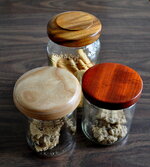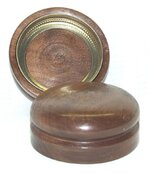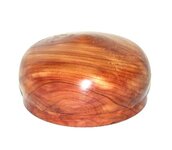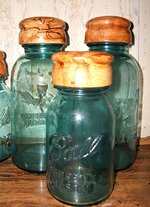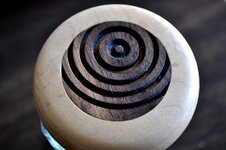monophoto
Member
In their latest catalog, PSI is offering kits for making decorative lids for Mason jars.
You don't need to buy a kit - just purchase food items (marinara sauce, etc) that comes in glass jars, and then recycle.
My wife is convinced that all plastic storage containers are toxic, and is replacing a 40+ year collection with recycled glass containers. And being the good husband that I am, I have been making decorative wood lids so that the containers look nice when arrayed on the kitchen counter. She repays my kindness with oatmeal or chocolate chip cookies. That's a good deal!
Seriously, I start with a scrap of hardwood that is at least 3/4" thick. I find the centers, mount it on a glue block, face off the underside, and then cut a recess large enough to contain the metal cap that came on the jar. You can measure the lid to determine the size of the recess, but the trial-and-error approach is required to get a good fit. Then, remove the blank from the glue block, flip it around and remount it using double-stick tape in the recess. Turn the top and sides, sand and finish. I've made the sides as thin as 1/16" - that looks attractive, but that's a bit thin and causes me to worry about cracking. The ideal thickness is probably somewhere between 1/8" and 1/4".
After finishing the top, I glue the metal lid that originally came on the jar into the recess using either epoxy or polyurethane glue. I prefer polyurethane because it will expand to fill any gaps between the turned lid and the underlying metal lid, but the downside is that it can foam out around the edges. That can be brimmed away after the glue has cured for 24 hours, but trimming is just an extra step. Also, it is necessary to clamp the metal lid to the wood cap when using polyurethane to prevent the foaming from separating them while the glue cures.
You don't need to buy a kit - just purchase food items (marinara sauce, etc) that comes in glass jars, and then recycle.
My wife is convinced that all plastic storage containers are toxic, and is replacing a 40+ year collection with recycled glass containers. And being the good husband that I am, I have been making decorative wood lids so that the containers look nice when arrayed on the kitchen counter. She repays my kindness with oatmeal or chocolate chip cookies. That's a good deal!
Seriously, I start with a scrap of hardwood that is at least 3/4" thick. I find the centers, mount it on a glue block, face off the underside, and then cut a recess large enough to contain the metal cap that came on the jar. You can measure the lid to determine the size of the recess, but the trial-and-error approach is required to get a good fit. Then, remove the blank from the glue block, flip it around and remount it using double-stick tape in the recess. Turn the top and sides, sand and finish. I've made the sides as thin as 1/16" - that looks attractive, but that's a bit thin and causes me to worry about cracking. The ideal thickness is probably somewhere between 1/8" and 1/4".
After finishing the top, I glue the metal lid that originally came on the jar into the recess using either epoxy or polyurethane glue. I prefer polyurethane because it will expand to fill any gaps between the turned lid and the underlying metal lid, but the downside is that it can foam out around the edges. That can be brimmed away after the glue has cured for 24 hours, but trimming is just an extra step. Also, it is necessary to clamp the metal lid to the wood cap when using polyurethane to prevent the foaming from separating them while the glue cures.

